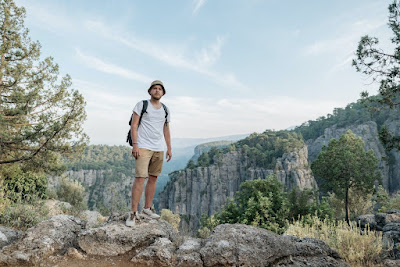There are lots of different opinions about packing gear for a hike, but they basically fall into two different camps. On the one hand, you can subscribe to the Boy Scout motto of "Be Prepared" and try to include everything you may need for any situation you are likely to encounter.
There is wisdom in that approach. Since you are away from civilization, you
will be forced to rely on whatever you have with you. Or on the other hand, you
might choose to "Travel Light" and carry only the barest essentials.
This choice has its benefits too, since you will be packing along every
pound of gear you load into your backpack, and you want to enjoy your hike,
not come out of it feeling like you've spent the day as a pack mule.
Choosing the right backpack to suit your
hiking style is the first step. One of the first things to look at is capacity.
If you are one of the "prepared" hikers, you'll probably want
something like the larger Badlands Backpacks (the 2200) featured here.
If you are more of the "travel light" kind of hiker (or are
small yourself), you may want to consider a smaller backpack. The
duration of your trip is going to be a big factor as well, since you'll need
space to carry food and water.
Expanding capacity can give you more versatility,
especially if you are going on a long hike (carrying a lot of food and
water), hunting (planning to carry out meat), or expect to pick up things along
the way and bring them out. Once you decide how much capacity will fit your
needs, make sure the frame is strong enough to keep the load distributed
without adding a lot of extra weight or bulk. Check for wide, padded,
adjustable shoulder straps that will allow you to carry the weight comfortably.
Be sure to choose a backpack that features a
number of compartments, both inside and out, with closures that are easy to
manage. These will help you know where your gear is, and be able to get to it
easily. Your phone and keys can stay safely tucked into their inside pockets
while your water is at hand stored in an outside pocket.
Once you've chosen your backpack, what do you
put in it? We're not going to give you the Boy Scout list, since that could
include a lot of items and will depend on your particular situation. But every hiker
should carry a few basic items.
•
flashlight (even if you don't plan to be out after dark)
•
food and water (more than you need for your planned trip)
• protective
items (hat, sunscreen, insect repellant)
• biodegradable
toilet paper
• a
basic first aid kit (at the very least you should be able to treat cuts)
• a
map of the area and a compass (just in case!) - unless of course you have a GPS
unit that will work on the trail
• poncho
or other rain gear if there is any chance at all of rain (remember in some
places there is ALWAYS that chance and it is often unexpected)
• a
pair of dry socks - may not be on everyone's "essential" list, but if
you get your socks wet, you run a big risk of developing blisters; for the
small space taken by an extra pair, it's probably worth the extra protection
Of course, when planning your hiking trip, you'll
want to give careful consideration to how you dress. Dressing in layers of
clothing that will wick away moisture and dry easily is the best way to stay
comfortable. Your shoes are one of the most important pieces of equipment.
While you don't necessarily need hiking boots, you should have a pair of shoes
that protect your feet (tennis shoes as opposed to sandals) and give you good
traction on the path, through mud, and over stones.
With good preparation, you'll be ready for an
enjoyable hike. If it were me, I'd have to add a camera to the
"essential" list to record all that enjoyment to savor later.


Comments
Post a Comment